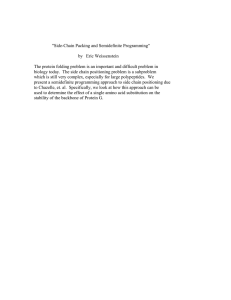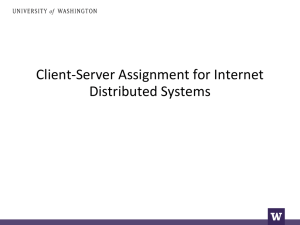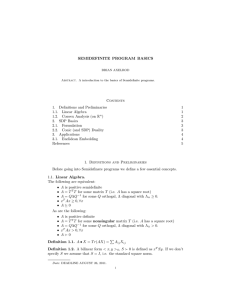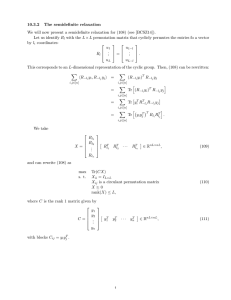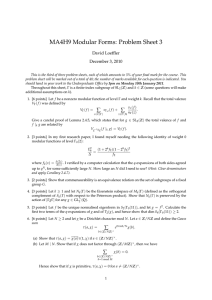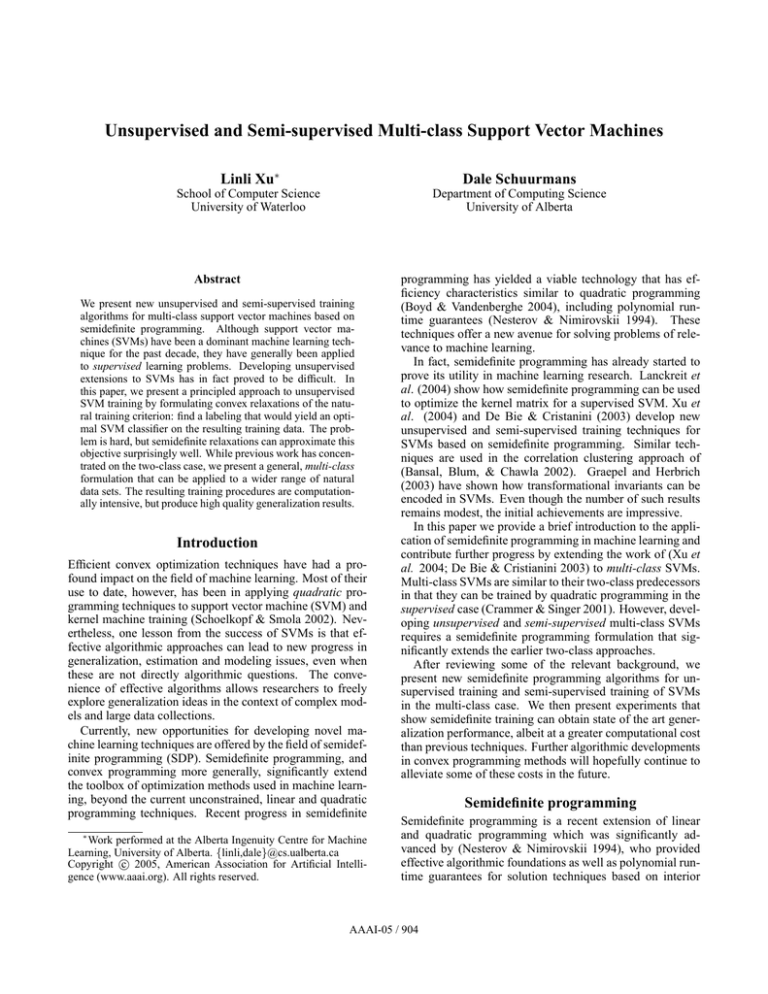
Unsupervised and Semi-supervised Multi-class Support Vector Machines
Linli Xu∗
Dale Schuurmans
School of Computer Science
University of Waterloo
Department of Computing Science
University of Alberta
Abstract
We present new unsupervised and semi-supervised training
algorithms for multi-class support vector machines based on
semidefinite programming. Although support vector machines (SVMs) have been a dominant machine learning technique for the past decade, they have generally been applied
to supervised learning problems. Developing unsupervised
extensions to SVMs has in fact proved to be difficult. In
this paper, we present a principled approach to unsupervised
SVM training by formulating convex relaxations of the natural training criterion: find a labeling that would yield an optimal SVM classifier on the resulting training data. The problem is hard, but semidefinite relaxations can approximate this
objective surprisingly well. While previous work has concentrated on the two-class case, we present a general, multi-class
formulation that can be applied to a wider range of natural
data sets. The resulting training procedures are computationally intensive, but produce high quality generalization results.
Introduction
Efficient convex optimization techniques have had a profound impact on the field of machine learning. Most of their
use to date, however, has been in applying quadratic programming techniques to support vector machine (SVM) and
kernel machine training (Schoelkopf & Smola 2002). Nevertheless, one lesson from the success of SVMs is that effective algorithmic approaches can lead to new progress in
generalization, estimation and modeling issues, even when
these are not directly algorithmic questions. The convenience of effective algorithms allows researchers to freely
explore generalization ideas in the context of complex models and large data collections.
Currently, new opportunities for developing novel machine learning techniques are offered by the field of semidefinite programming (SDP). Semidefinite programming, and
convex programming more generally, significantly extend
the toolbox of optimization methods used in machine learning, beyond the current unconstrained, linear and quadratic
programming techniques. Recent progress in semidefinite
∗
Work performed at the Alberta Ingenuity Centre for Machine
Learning, University of Alberta. {linli,dale}@cs.ualberta.ca
Copyright °
c 2005, American Association for Artificial Intelligence (www.aaai.org). All rights reserved.
programming has yielded a viable technology that has efficiency characteristics similar to quadratic programming
(Boyd & Vandenberghe 2004), including polynomial runtime guarantees (Nesterov & Nimirovskii 1994). These
techniques offer a new avenue for solving problems of relevance to machine learning.
In fact, semidefinite programming has already started to
prove its utility in machine learning research. Lanckreit et
al. (2004) show how semidefinite programming can be used
to optimize the kernel matrix for a supervised SVM. Xu et
al. (2004) and De Bie & Cristanini (2003) develop new
unsupervised and semi-supervised training techniques for
SVMs based on semidefinite programming. Similar techniques are used in the correlation clustering approach of
(Bansal, Blum, & Chawla 2002). Graepel and Herbrich
(2003) have shown how transformational invariants can be
encoded in SVMs. Even though the number of such results
remains modest, the initial achievements are impressive.
In this paper we provide a brief introduction to the application of semidefinite programming in machine learning and
contribute further progress by extending the work of (Xu et
al. 2004; De Bie & Cristianini 2003) to multi-class SVMs.
Multi-class SVMs are similar to their two-class predecessors
in that they can be trained by quadratic programming in the
supervised case (Crammer & Singer 2001). However, developing unsupervised and semi-supervised multi-class SVMs
requires a semidefinite programming formulation that significantly extends the earlier two-class approaches.
After reviewing some of the relevant background, we
present new semidefinite programming algorithms for unsupervised training and semi-supervised training of SVMs
in the multi-class case. We then present experiments that
show semidefinite training can obtain state of the art generalization performance, albeit at a greater computational cost
than previous techniques. Further algorithmic developments
in convex programming methods will hopefully continue to
alleviate some of these costs in the future.
Semidefinite programming
Semidefinite programming is a recent extension of linear
and quadratic programming which was significantly advanced by (Nesterov & Nimirovskii 1994), who provided
effective algorithmic foundations as well as polynomial runtime guarantees for solution techniques based on interior
AAAI-05 / 904
point methods. Semidefinite programming has since had
a profound impact on the field of combinatorial optimization (Goemans & Williamson 1995), and, as mentioned,
has opened up exciting new avenues of research in machine
learning (Lanckriet et al. 2004). Before explaining the direct
relevance of these formulations to generalized SVM training, we first briefly review the basic concepts.
The statement of a semidefinite programming problem,
as well as the description of the interior point solution approach, are both very simple. A semidefinite programming
problem is a convex constrained optimization problem where
one optimizes a symmetric n × n matrix of variables X
min hC, Xi
X
subject to
Qn
X, det(X) = i=1 λi , the product
Pn of eigenvalues (Strang
1998). Thus, − log(det(X)) = i=1 log(1/λi ). So as any
eigenvalue approaches 0 the barrier function goes to infinity and prevents the constraint X º 0 from being violated.
Crucially, the barrier function − log(det(X)) is also a convex function of X.
Therefore, an overall interior point (path following)
method for solving semidefinite programs is constructed
roughly as follows. First, a tightness parameter µ is set to
ensure numerical stability. One then solves the barrier formulation of (1), which is a fully convex optimization problem
hAi , Xi = bi , i = 1...m
Xº0
min hC, Xi − µ log(det(X)) subject to
X
(1)
hAi , Xi = bi , i = 1...m (2)
where h·, ·iPdenotes the simple matrix inner product,
hC, Xi =
ij cij xij , and X º 0 denotes the constraint
that X must remain positive semidefinite (Helmberg 2000;
Boyd & Vandenberghe 2004). Here, the objective is linear
in X, and the semidefinite constraint simply means that X
must satisfy z> Xz ≥ 0 for any vector z 6= 0. For a symmetric X, this is true if and only if X has only nonnegative
eigenvalues (Strang 1998). Since z> Xz = hX, zz> i, one
can see that a semidefinite program is a generalized form of
linear program on X with infinitely many linear constraints
For a given µ, this can be efficiently solved using Newton’s
method, in space linear in the size of the original problem
(Helmberg 2000). Then µ is reduced by a fixed multiplier,
typically µ(k+1) = µ(k) /10, and the process is repeated. It
can be shown that as µ → 0 the solution to (2) approaches
(1) (Boyd & Vandenberghe 2004). In practice, the iteration
is stopped at a small value of µ.
In fact, there already exist many software packages on the
Web for solving semidefinite programming problems using
barrier methods, including SeDuMi, SDPT3 and CSDP (see
www.optimization-online.org). Although these techniques
are not as well developed as methods for solving quadratic
programs, progress is continuing and the current tools are
starting to become adequate for solving practical problems.
min hC, Xi
X
subject to
hAi , Xi = bi , i = 1...m
hX, zz> i ≥ 0, ∀z 6= 0
Of course the infinitely many linear constraints in fact define
a non-linear constraint on X (a semi-infinite program). Nevertheless, the semidefinite constraint is still a convex constraint on X. That is, for any two positive semidefinite matrices X and Y , any convex combination will be positive
semidefinite, since z> (ρX + (1 − ρ)Y )z = ρz> Xz + (1 −
ρ)z> Y z ≥ 0 for 0 ≤ ρ ≤ 1. The dual form of (1) is
P
max b> y subject to Z + i yi Ai = C, Z º 0
y,Z
(Helmberg 2000; Boyd & Vandenberghe 2004). Below we
will see how this type of problem can naturally arise when
one attempts to generalize SVM training.
Convex optimization problems generally admit effective
algorithmic approaches (Nesterov & Nimirovskii 1994). It
has become apparent that interior point (or “barrier”) methods are one of the most effective approaches for solving
these problems (Boyd & Vandenberghe 2004; Helmberg
2000; Vanderbei 1996). An appealing aspect of popular barrier methods, beyond their effectiveness, is that they are also
very intuitive: To handle inequality constraints, one simply
replaces them with a convex barrier function that ensures
the constraint is satisfied. Doing so removes the inequality
constraints from the problem and replaces them with convex terms in the optimization objective, yielding a problem
that can be easily solved—for example by using Newton’s
method. In the case of a semidefinite constraint X º 0 there
is a particularly elegant barrier function: − log(det(X)).
To see how this works, note that for a symmetric matrix
Two-class SVM training algorithms
We first briefly review the results that have been obtained
for generalized two-class SVM training. First, to establish
the background ideas from SVMs as well as establish the
notation we will use, we consider the supervised case.
Assume we are given labeled training examples
(x1 , y 1 ), ..., (xn , y n ) where each example is assigned a binary label y i ∈ {−1, +1}. The goal of an SVM of course is
to find the linear discriminant fw,b (x) = w> φ(x) + b that
maximizes the minimum misclassification margin
γ ∗ = max γ
w,b,γ
subject to
y i (w> φ(xi ) + b) ≥ γ ∀i
kwk2 = 1
(3)
Here the Euclidean normalization constraint on w ensures
that the Euclidean distance between the data and the separating hyperplane (in φ(x) space) determined by w∗ , b∗ is
maximized. It is easy to show that this same w∗ , b∗ is a
solution to the quadratic program
γ ∗−2 = min
w,b
2
1
2 kwk
subject to y i (w> φ(xi ) + b) ≥ 1 ∀i
Importantly, the minimum value of this quadratic program,
γ ∗−2 , is just the inverse square of the optimal solution value
γ ∗ to (3) (Lanckriet et al. 2004).
To cope with potentially inseparable data, one normally
introduces slack variables to reduce the dependence on noisy
AAAI-05 / 905
examples. This leads to the so called soft margin SVM (and
its dual) which is controlled by a tradeoff parameter β
γ ∗−2
=
min β kwk2
w,b,ξ 2
+ ξ > e subject to ξ ≥ 0,
label kernel matrix M = yy> . The main advantage of doing so is that the inverse soft margin γ ∗−2 is in fact a convex
function of M (Lanckriet et al. 2004)
γ ∗−2 (M ) =
y i (w> φ(xi ) + b) ≥ 1 − ξi ∀i
=
max λ> e −
λ
1
2β hK
◦ λλ> , yy> i subject to
>
0 ≤ λ ≤ 1, λ y = 0
(4)
The notation we use in this second (dual) formulation requires some explanation, since we will use it below: Here
K denotes the n × n kernel matrix formed from the inner
products of feature vectors Φ = [φ(x1 ), ..., φ(xn )] such
that K = Φ> Φ. Thus Kij = φ(xi )> φ(xj ). The vector e denotes the vector of all 1 entries. We let A ◦ B denote componentwise matrix multiplication. Note that (4) is
derived from the standard dual SVM by using the fact that
λ> (K ◦ yy> )λ = hK ◦ yy> , λλ> i = hK ◦ λλ> , yy> i.
Thus for supervised SVM training, one takes a given set
of labeled training data (x1 , y 1 ), ..., (xn , y n ), forms the kernel matrix K on data inputs, forms the kernel matrix yy>
on target outputs, sets the slack parameter β, and solves the
quadratic program (4) to obtain the dual solution λ∗ and the
inverse square maximum margin value γ ∗−2 . Once these are
obtained, one can then recover a classifier directly from λ∗
(Schoelkopf & Smola 2002).
Unsupervised two-class SVMs
Recently it has been observed that semidefinite programming can be used for unsupervised training of two-class
SVMs (Xu et al. 2004; De Bie & Cristianini 2003). The
goal in this case is not to find a large margin classifier given
labels on the data, but instead to find a labeling that results
in a large margin classifier. This amounts to an intuitive twoclass clustering principle: find a labeling so that if one were
to subsequently run an SVM, the margin obtained would
be maximal over all possible labellings (Joachims 1999;
Bennett & Demiriz 1998). Unsurprisingly, this is a hard
computational problem. However, with some reformulation it can be approximated by a semidefinite program that
can efficiently compute a good solution (Xu et al. 2004;
De Bie & Cristianini 2003).
Suppose one was given unlabeled data x1 , .., xn , and
wished to solve for a labeling y ∈ {−1, +1}n that leads
to a maximum (soft) margin. Straightforwardly, one could
attempt to tackle this optimization problem directly
min
y∈{−1,+1}n
where
γ ∗−2 (y)
subject to
γ ∗−2 (y) = max λ> e −
λ
− ² ≤ e> y ≤ ² (5)
1
hK ◦ λλ> , yy> i
2β
subject to 0 ≤ λ ≤ 1
Unfortunately, γ ∗−2 (y) is not a convex function of y, and
this formulation does not lead to an effective algorithmic
approach. To obtain an efficient technique for solving this
problem one first re-expresses the optimization, not directly
in terms of the cluster labels y, but instead in terms of the
max λ> e −
λ
subject to
1
2β hK
◦ λλ> , M i
0≤λ≤1
The convexity of γ ∗−2 with respect to M is easy to establish
since this quantity is just a maximum over linear functions
of M (Boyd & Vandenberghe 2004).
Working with the matrix M turns out to be particularly
convenient here because of the following useful fact: if
Mij = yi yj , then Mij = 1 if and only if yi = yj , and
Mij = −1 otherwise. That is, for M ∈ {−1, +1}n×n ,
M = yy> for some y if and only if M is an equivalence
relation matrix. Therefore the optimization problem (5) can
be cast as working directly with equivalence relations M instead of example labellings y. (We will need to exploit this
observation below for the multi-class case.)
Conveniently, the property of being an equivalence relation matrix can be enforced with a simple semidefinite constraint, since M ∈ {−1, +1}n×n encodes an equivalence
relation if and only if diag(M ) = e and M º 0 (Helmberg 2000; Laurent & Poljak 1995). However, in addition,
one clearly needs to impose some sort of constraint on the
class balance, since otherwise one could simply assign all
the data points to the same class and obtain an unbounded
margin. This can be enforced with an additional linear constraint −²e ≤ M e ≤ ²e.
Therefore, putting the pieces together, one is left with an
optimization problem on M that has a convex objective and
convex constraints, except for the integer constraint M ∈
{−1, +1}n×n . Dropping the integer constraint yields the
convex relaxation of the maximum margin labeling problem:
min max λ> e −
M
λ
1
2β hK
◦ λλ> , M i subject to
0 ≤ λ ≤ 1, diag(M ) = e, M º 0, −²e ≤ M e ≤ ²e (6)
This can be turned into an equivalent semidefinite program
(Xu et al. 2004)
min
M,g,µ,ν
g
subject to
·
M ◦K
(e + µ − ν)>
e+µ−ν
g − β2 ν > e
¸
º0
(7)
diag(M ) = e, M º 0, −²e ≤ M e ≤ ²e
∗
Given a solution M√
to (7) one can recover a soft clustering
y by setting y = λ1 v1 , where λ1 , v1 are the maximum
eigenvalue and corresponding eigenvector of M ∗ .
The results in (Xu et al. 2004) show that this method
obtains clustering performance that often exceeds spectral
clustering (Ng, Jordan, & Weiss 2001). However, a significant drawback of the method is the restriction to two-classes.
Semi-supervised two-class SVMs
Before considering multi-class extensions to this SVM training technique, we first note that these clustering algorithms
can easily be extended to semi-supervised SVM training.
AAAI-05 / 906
For semi-supervised training, one assumes that a small labeled training set (x1 , y 1 ), ..., (xn , y n ) given as well as an
unlabeled training set xn+1 , ..., xN . The goal in this case is
to combine the information in these two data sets to produce
a more accurate classifier.
It turns out to be very straightforward to extend the previous equivalence relation based clustering procedures to
semi-supervised training. One simply adds constraints on
the matrix M to force it to respect the observed equivalence
relations among the labeled training data: Mij = yi yj for
labeled examples i, j ∈ {1, ..., n}. Note that the observed
training labels yi for i ∈ {1, ..., n} are constants, and therefore the new constraints are still linear in the parameters of
M that are being optimized. The resulting method, although
a simple extension, appears to obtain superior performance
to previous semi-supervised training procedures for SVMs
(Joachims 1999; Bennett & Demiriz 1998).
Multi-class formulation
Our main technical contribution in this paper is to extend
the previous two-class methods to general multi-class SVM
training algorithms. Although our strategy is similar to that
employed above, there are some significant complications to
deriving an effective training procedure.
As before, we start with the supervised case. Assume
we are given labeled training examples (x1 , y 1 ), ..., (xn , y n )
where each example is assigned a label from a fixed finite set y i ∈ {1, ..., `}. Here, we need to extend our
feature functions φ(x, y) to include the y-labels explicitly,
which provides a separate weight vector wk for each class
k. Once a complete weight vector has been learned, subsequent test examples x are classified according to y ∗ =
arg maxy w> φ(x, y). The dominant multi-class training
procedure for SVMs is due to (Crammer & Singer 2001),
which, including slack variables, is formulated as
ω
= min
w,ξ
β
2
2 kwk
+ ξ> e
subject to
w> (φ(xi , y i ) − φ(xi , k)) ≥ δ(y i , k) − ξi ∀i,k (8)
where δ(y i , k) = 1(yi 6=k) , and ω is the multi-class analog of
the inverse squared margin γ ∗−2 . Our main result depends
crucially on being able to reformulate the quadratic program
(8) so that it can be expressed entirely in terms of equivalence relation matrices instead of individual y-labels. To
achieve this, we need to derive a different formulation of the
dual from that given in (Crammer & Singer 2001).
Unsupervised multi-class SVMs
With some work, one can show that the following quadratic
program is equivalent to the dual of (8).
Proposition 1 The dual quadratic program of (8) can be reformulated as
Here D and Λ are n×` matrices, M and K are n×n matrices, and we define the equivalence relation indicator matrices M and D such that Mij = 1(yi =yj ) and Dik = 1(yi =k)
respectively. An important consequence of these definitions,
which we exploit below, is that M = DD> .
This is not the same formulation of the dual to (8) given
in (Crammer & Singer 2001). Importantly, this reformulation of the dual expresses the problem explicitly in terms of
the equivalence relations M and D—which gives us a necessary advantage over the formulation of the dual given in
(Crammer & Singer 2001).
We can now establish our main result. We would like to
compute a solution to the problem
subject to M = DD>
min ω(M, D)
M,D
M ∈ {0, 1}n×n , D ∈ {0, 1}n×`
A solution to this problem will minimize the inverse square
margin criterion ω and thus maximize the original margin
criterion. However, just as in the two-class case, we need
to worry about class balance, because a large margin value
can always be achieved by eliminating classes. To impose
class balance in the multi-class case we add the constraint
( 1` − ²)ne ≤ M e ≤ ( 1` + ²)ne for some ².
The overall formulation, to this point, enjoys the advantage that the objective ω(M, D) is jointly convex in M and
D. Unfortunately, neither the integer constraints nor the
nonlinear constraint M = DD> are convex. Therefore, as
before, we need to derive a convex relaxation to this problem
that preserves as much of the structure of the problem as possible. To do so, we first relax the constraint that M and D be
{0, 1}-valued, and instead allow them to take values in [0, 1].
However, we also have to cope with the nonlinear equality
constraint M = DD> . To remove the non-convexity implicit in the nonlinear equality, we replace it with the convex
inequalities M º DD> and diag(M ) = e. The resulting
problem is a convex optimization over M and D.
min ω(M, D) subject to 0 ≤ M ≤ 1, 0 ≤ D ≤ 1
M,D
diag(M ) = e, M º DD>
1
1
( − ²)ne ≤ M e ≤ ( + ²)ne (10)
`
`
This in fact yields the convex optimization problem we wish
to solve.
To tackle this problem in practice, it is convenient to first
reformulate it as a semidefinite program.
Proposition 2 The convex optimization problem (10) is
equivalent to
g
subject to
min
M,D,V,α,g
·
¸
I ⊗K
c
(11)
c>
g + 1 hK, M i + 2 α> e º 0
ω(M, D) = max Q(Λ, M, D) subject to Λ ≥ 0, Λe = e
Λ
1
hK, M i +
where Q(Λ, M, D) = t − hD, Λi − 2β
1
1
>
hKD,
Λi
−
β
2β hΛΛ , Ki
(9)
·
I
D
>
D
M
¸
β2
β
º0
diag(M ) = e, 0 ≤ M ≤ 1, 0 ≤ D ≤ 1, V ≥ 0
( 1` − ²)ne ≤ M e ≤ ( 1` + ²)ne
AAAI-05 / 907
where c = vec( β1 KD − D + V + αe> ).1
This formulation re-expresses the problem in a form that
can be solved by conventional semidefinite programming
techniques (Helmberg 2000; Boyd & Vandenberghe 2004).
Semi-supervised multi-class SVMs
Again, before presenting experimental results, we briefly
note that the above formulation of unsupervised multi-class
SVM training can easily be extended to semi-supervised
learning. The extension of the unsupervised training procedure to the semi-supervised case proceeds similarly to the
two-class case. Here we simply add the constraints in the observed labels to the semidefinite program: Mij = 1(yi =yj )
for all labeled training pairs i, j, and Dik = 1(yi =k) for each
labeled training pair and class label i, k. The remainder of
the program is equivalent to (11), and thus still defines a
semidefinite programming problem that can be solved by
standard methods.
Experimental results
We implemented the generalized multi-class SVM training procedures based on (11) using the semidefinite programming package SDPT3 available at www.optimizationonline.org.
Results for the unsupervised and semisupervised formulations respectively are reported below.
Unsupervised results
First, for unsupervised training, we compared the performance of our semidefinite multi-class clustering technique
to the spectral clustering method of (Ng, Jordan, & Weiss
2001) and also straightforward k-means clustering. Both
semidefinite clustering and spectral clustering were run with
the same radial basis function kernel and matching width
parameters. In fact, in each case, we chose the best width
parameter for spectral clustering by searching over a small
set of five widths related to the scale of the problem. In
addition, the slack parameter for maximum margin clustering was simply set to an arbitrary value.2 To assess clustering performance we first took a set of labeled data, removed
the labels, ran the clustering algorithms, labeled each of the
resulting clusters with the majority class according to the
original training labels, and finally measured the number of
misclassifications made by each clustering.
Our first experiments were conducted on the synthetic
data sets depicted in Figure 1. Table 1 shows that for
the first four sets of data (AAAI, Circle&Balls, 3JoinedCircles, Squiggles) semidefinite and spectral clustering obtained identical small error rates, which were in turn significantly smaller than those obtained by k-means (except for
the AAAI case).
We also conducted clustering experiments on two real
data sets consisting of images of hand-written digits; see
1
The notation vec(X) means turning X into a vector by concatenating its columns. A ⊗ B denotes the Kronecker product.
2
It turns out that the slack parameter β did not have a significant
effect on any of our preliminary investigations, so we just set it to
β = 0.01 for all of the experiments reported here.
Figures 2 and 3. The first data set, DigitsA, consists of black
and white images of 20 × 16 pixels, as shown in Figure 2.
The second data set, DigitsB, consists of grey scale images
of 16 × 16 pixels, as shown in Figure 3. Table 1 shows that
semidefinite clustering demonstrates a significant advantage
over k-means clustering on these data sets, but also a systematic advantage over spectral clustering. (See the Table 1
caption for details of the experimental set up.)
Semi-supervised results
We tested our approach to semi-supervised learning on various data sets from the UCI repository. To the best of
our knowledge, there are no other semi-supervised training procedures available for multi-class SVMs that apply the
large margin approach of (Joachims 1999; Bennett & Demiriz 1998) or the semidefinite approach we develop above.
Therefore, we compare to standard supervised multi-class
SVMs (Crammer & Singer 2001) but also to a general semisupervised approach based on clustering the data using spectral clustering, and then using the labeled data to assign minimum error labels to the classes. In each case, we evaluated
the techniques transductively. That is, we split the data into
a labeled and unlabeled part, held out the labels of the unlabeled portion, trained the semi-supervised techniques, reclassified the unlabeled examples using the learned results,
and measured the misclassification error on the held out labels.
In these experiments, we used two UCI data sets
(Balance-scale and Cars), one of the hand-written digits
data sets (DigitsA), and a data set of face images. Here
we see that the semi-supervised semidefinite approach tends
to outperform the other methods, particularly on the digits data. Generally, semi-supervised training shows an advantage over strictly supervised training which ignores the
extra unlabeled data. Table 2 shows that the semidefinite
SVM method is effective at exploiting unlabeled data to improve the prediction of held out labels. In every case (except
5faces), it significantly reduces the error of standard multiclass SVM, and obtains the best overall performance of the
semi-supervised learning techniques we have investigated.
(See the Table 2 caption for details of the experimental set
up.)
Conclusion
We have proposed a general, unified principle for clustering
and semi-supervised learning based on the maximum margin
principle popularized by supervised SVMs. Our work generalizes previous approaches to the multi-class case. Our
results on both unsupervised and semi-supervised learning
are competitive with, and sometimes exceed the state of the
art. Overall, semidefinite programming appears to be an effective approach for unifying and generalizing SVM training
techniques, and applying SVMs to a wider range of circumstances, like unsupervised and semi-supervised learning.
We plan to extend these results to the multivariate case
where there are multiple, correlated y labels associated with
the input data observations. Recently, substantial progress
has been made on learning classifiers that make dependent
AAAI-05 / 908
AAAI, 4 clusters
7
circleandballs, 3 clusters
3
6
2
5
4
1
3
2
0
1
−1
0
−1
−2
−2
−3
−3
−4
0
2
4
6
8
10
−5
threejoinedcircles, 3 clusters
3
0
5
squiggles, 4 clusters
4.5
4
2
3.5
1
3
0
2.5
2
−1
1.5
−2
−3
1
−3
−2
−1
0
1
2
3
0.5
1
2
3
4
5
Clustering:
AAAI
Circle&Balls
3Circles
Squiggles
DigitsA689∗
DigitsA689
DigitsB689
DigitsA0689∗
DigitsA0689
DigitsB0689
Semidefinite
0
0
4.0
0
3.4
7.2 ±1.3
13.3 ±2.8
7.5
11.6 ±1.8
21.1 ±2.3
Spectral
0
0
4.0
0
12.0
12.3 ±2.3
15.1 ±3.9
9.2
20.4 ±2.4
25.8 ±2.6
Kmeans
0
18.7
47.3
28.3
12.0
14.0 ±4.4
18.5 ±4.6
38.3
24.1 ±4.1
27.7 ±4.4
Table 1: Clustering results: Percentage misclassification errors of the various clustering algorithms on the various data
sets (± one standard deviation). DigitsA are the results on
the black and white digit data set, and DigitsB are the results on the grey scale digit data set. The digits included
in the data sample are explicitly indicated. DigitsA∗ reports
one run using all 39 examples of each digit. DigitsA reports
10 repeats of subsampling 20 out of 39 examples of each
digit. DigitsB reports 10 repeats of subsampling 30 out of
1100 examples of each digit.
Figure 1: Four artificial data sets used in the clustering experiments.
Figure 4: A sampling of the face data (three people).
Figure 2: A sampling of handwritten digit images from the
first data set, DigitsA (zeros, sixes, eights and nines).
predictions of test labels that are explicitly related (Taskar,
Guestrin, & Koller 2003; Altun, Tsochantaridis, & Hofmann
2003; Tsochantaridis et al. 2004). The work of (Taskar,
Guestrin, & Koller 2003), in particular, considers maximum
margin Markov networks, which are directly a multivariate version of SVMs. Developing convex unsupervised and
semi-supervised training algorithms for maximum margin
Markov networks remains an important challenge.
Acknowledgments
Research supported by the Alberta Ingenuity Centre for Machine Learning, NSERC, MITACS, CFI, and the Canada Research Chairs programme.
References
Figure 3: A sampling of handwritten digit images from the
second data set, DigitsB (zeros, sixes, eights and nines).
Altun, Y.; Tsochantaridis, I.; and Hofmann, T. 2003. Hidden Markov support vector machines. In Proceedings International Conference on Machine Learning (ICML-03).
Bansal, N.; Blum, A.; and Chawla, S. 2002. Correlation
clustering. In Conference on Foundations of Computer Science (FOCS-02).
Bennett, K., and Demiriz, A. 1998. Semi-supervised sup-
AAAI-05 / 909
Figure 5: A sampling of the face data (five people).
Semi-sup:
UCI:Balance-scale
UCI:Cars
DigitsA689
DigitsA0689
3faces
5faces
Semidef
24.1 ±1.7
41.9 ±0.4
5.6 ±0.7
6.5 ±0.5
0
5.2 ±1.5
supSVM
30.3 ±2.4
43.1 ±1.4
16.3 ±1.6
20.6 ±3.3
10.0 ±2.0
14.4 ±1.7
Spectral
26.3 ±4.3
43.2 ±0.4
12.7 ±0.3
11.8 ±2.7
0
0
Table 2: Semi-supervised learning results: Percentage misclassification errors of the various semi-supervised learning
algorithms on the various data sets (± one standard deviation). 10 repeats, each randomly subsampling 1/10 of the
data to be labeled. Data set sizes are: UCI:Balance-scale: 3
classes, 40 examples each. UCI:Cars: 3 classes, 40 examples each. DigitsA689: 3 classes, 39 examples each. DigitsA0689: 4 classes, 39 examples each. 3faces: 3 classes, 32
examples each. 5faces: 5 classes, 30 examples each.
binatorial optimization. Technical Report ZIB-Report ZR00-34, Konrad-Zuse-Zentrum Berlin.
Joachims, T. 1999. Transductive inference for text classification using support vector machines. In International
Conference on Machine Learning (ICML-99).
Lanckriet, G.; Cristianini, N.; Bartlett, P.; Ghaoui, L.; and
Jordan, M. 2004. Learning the kernel matrix with semidefinite programming. Journal of Machine Learning Research
5.
Laurent, M., and Poljak, S. 1995. On a positive semidefinite relaxation of the cut polytope. Linear Algebra and its
Applications 223/224.
Nesterov, Y., and Nimirovskii, A. 1994. Interior-Point
Polynomial Algorithms in Convex Programming. SIAM.
Ng, A.; Jordan, M.; and Weiss, Y. 2001. On spectral clustering: analysis and an algorithm. In Advances in Neural
Information Processing Systems 14 (NIPS-01).
Schoelkopf, B., and Smola, A. 2002. Learning with Kernels: Support Vector Machines, Regularization, Optimization, and Beyond. MIT Press.
Strang, G. 1998. Introduction to Linear Algebra.
Wellesley-Cambridge Press.
Taskar, B.; Guestrin, C.; and Koller, D. 2003. Max-margin
Markov networks. In Advances in Neural Information Processing Systems 16 (NIPS-03).
Tsochantaridis, I.; Hofmann, T.; Joachims, T.; and Altun,
Y. 2004. Support vector machine learning for interdependent and structured output spaces. In Proceedings International Conference on Machine Learning (ICML-04).
Vanderbei, R. 1996. Linear Programming: Foundations
and Extensions. Kluwer.
Xu, L.; Neufeld, J.; Larson, B.; and Schuurmans, D. 2004.
Maximum margin clustering. In Advances in Neural Information Processing Systems 17 (NIPS-04).
port vector machines. In Advances in Neural Information
Processing Systems 11 (NIPS-98).
Boyd, S., and Vandenberghe, L. 2004. Convex Optimization. Cambridge U. Press.
Crammer, K., and Singer, Y. 2001. On the algorithmic
interpretation of multiclass kernel-based vector machines.
Journal of Machine Learning Research 2.
De Bie, T., and Cristianini, N. 2003. Convex methods for
transduction. In Advances in Neural Information Processing Systems 16 (NIPS-03).
Goemans, M., and Williamson, D. 1995. Improved
approximation algorithms for maximum cut and satisfiability problems using semidefinite programming. JACM
42:1115–1145.
Graepel, T., and Herbrich, R. 2003. Invariant pattern
recognition by semidefinite programming machines. In
Advances in Neural Information Processing Systems 16
(NIPS-03).
Helmberg, C. 2000. Semidefinite programming for com-
AAAI-05 / 910

